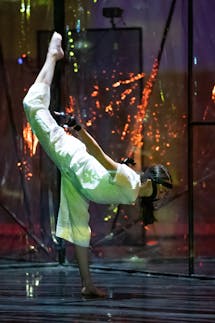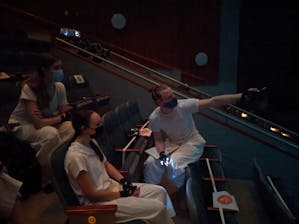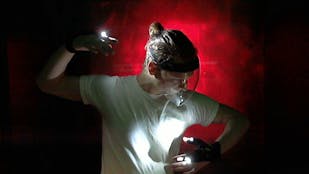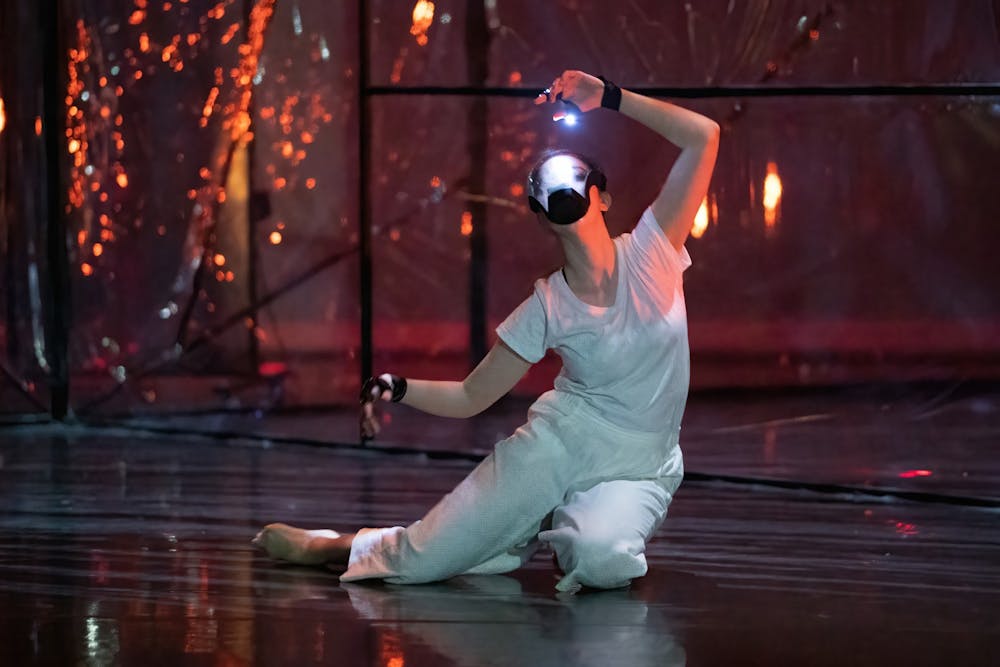Katy Maddalina wanted to challenge herself this semester, so she was excited when she found out she would be dancing in the inaugural MFA Dance Thesis Concert.
The concert — the first of its kind at UB — was streamed from April 16-18 on the UB Center for the Arts YouTube channel. The show featured the thesis work of two MFA student choreographers, Phil Wackerfuss and Kate Mackey, which they performed with a small group of undergrads. Rehearsals occurred over Zoom, but the performance footage consisted of the dancers performing outside and onstage in the CFA Drama Theatre. Dancers wore masks and used large, moveable clear vinyl walls to separate themselves from others. The CFA’s Video Production team filmed the show with their own equipment.
Unlike in a normal year, when dancers would have auditioned for their roles, Maddalina, a freshman dance major, and the other dance students, were required to submit an application to the Theatre and Dance Department. The department then paired the dancers with the show they would perform in.
And Maddalina, who performed in the piece “Telenauts” in the concert, loved the unique ideas explored in this production.
“There were some interesting concepts that you wouldn’t expect from a typical dance show. Because of COVID-19, there were extra precautions and stuff, but that actually led to some interesting sets, design and costuming,” Maddalina said. “We have these masks that were like helmets that could also light up, and we also had gloves that light up. We had projections on the dividers that divided us for more safety. So, we made the best of it, and it was designed in a certain way that made it beneficial to the production.”

Movement itself had to be considered differently because the dancers couldn’t run from one place to another or do other large movements.
The CFA streamed the production for free, although there was a suggested donation. Audience members registered to watch the virtual program by completing a short form on the Center for the Arts website. Shortly after submitting the form, audience members received an email with a link to the live stream and a PDF copy of the Playbill.
Ariel Nereson, an assistant professor and the director of graduate dance, was the faculty supervisor for the production. Nearson was tasked with ensuring that communication between the MFA students and production staff took place in a timely and professional manner.
Nereson wrote in an email to The Spectrum that the concert was free because it was the first of its kind and “we do yet not have data about how the show’s box office will impact our season’s budget overall, and so this year, given that so much is already quite different, we chose to make the show available to everyone without charge.”
Neerson says the MFA program was launched four years ago by UB faculty members. She says the program’s first graduating class — in spring 2020 — was unable to hold its thesis concert, because of COVID-19.
“This spring 2021 we are graduating our second class of MFA’s, and the MFA Dance Thesis Concert is the culmination of their three years of study at UB. The thesis work is a longer original work based on a unique research project,” Nereson wrote in the email. “Students work closely with their thesis advisor and committee members to create work that showcases synthesis of skills and a deeply informed personal aesthetic. Because of ongoing restrictions related to the pandemic, this year's thesis concert features dance films, dances that were made for the camera, which has turned out to be really exciting and inspiring for the students.”
Wackerfuss, a third year MFA dance graduate student, choreographed and performed in “Telenauts,” which opened the concert. Since the pandemic has forced people all across the world to interact primarily online, “Telenauts” explores the idea of whether an electronic image can have a physical presence.
“With dance, a lot of the impulsive energy people have comes from that in-person energy exchange with each other. So, how does that change when you take that from a three dimensional environment to a two dimensional environment?” Wackerfuss said. “[My thesis project is] about utilizing perspective and how we translate a physical sense of being around somebody through an electronic medium, and how do we mitigate and enhance that. It’s kind of like how our bodies are extended past their physical borders through this electronic medium. Can we still have a community? Do we still make connections? And, if so, what does that look like?”
The piece started out as an electronic arts project through the Department of Art. Wackerfuss created a doorway that had a “reactive touch surface,” which allows two people to stand on opposite sides, see each other and interact through the surface of the door. Wackerfuss created this in response to his own struggles coping with the physical separation caused by the pandemic.
“I have an extroverted part of myself that is a very physical person. I like doing a lot of partnering and weight sharing, and I do a lot of contact improv dance. So, going from that to a place where we’re just communicating through screens is very isolating, and it made me frustrated that I don’t get that kind of physical contact and interaction with people,” Wackerfuss said. “A prototype of [the doorway] does appear in my thesis. It’s not the full version of what I wanted, but this sort of translated into what I ended up working on.”
Since the whole piece was rehearsed over Zoom, Wackerfuss had to find creative ways to deal with the technological limitations and dance with the three undergraduate students performing in his piece: Maddalina, Alexis Corletta and Haley Sanders. Movement itself had to be considered differently because the dancers couldn’t run from one place to another or do other large movements. Wackerfuss didn’t even know what the stage was going to look like at the start of rehearsals.
“We mostly practiced improvising together. We were trying to do duets across a distance and see the moments that we would connect with each other. I had projectors set up in my house and I would project dancers on top of me, and then we would kind of move around each other and see where we overlapped and where our borders became permeable,” Wackerfuss said. “At this point, shapes become much more primary than the effort of the movement quality. So, it becomes important to say ‘what lines am I making?’ ‘Can I internalize this process so that when I am doing something that feels like a solo, it can still feel like a duet when overlapped with somebody somewhere else?’”

Wackerfuss experimented with lights and projections for his piece.
The vinyl barriers were eventually set up onstage in an “x” shape, leaving space for a dancer in each corner of the stage. To explore the idea of interacting with virtual images of people, the live dancers performed with the pre-recorded dancers who were projected onto vinyl walls.
“We recorded the dancers doing solos, and then those solos were projected on the vinyl that the dancers would then interact with. So, it has got a couple of different layers as far as live dancers versus recorded dancers,” Wackerfuss said. “What does it mean to be ‘present’ in that kind of situation? Can the recorded dancers still have some sense of presence when they are reprojected? And, it’s not a live thing, but now that it is working with a live dancer, it might become something else.”
Wackerfuss experimented with lights and projections for his piece. While performing onstage, Wackerfuss and the other three dancers wore see-through masks that covered their entire face. The masks buckled to the back of the dancers’ heads and had a light at the bottom that could be turned on. Sometimes, the videos of the dancers would be projected onto the clear surface of the mask. Along with the light-up gloves the dancers wore, lights appeared to fly across the air as the dancers performed on the dimly lit stage.
Several cameras were used at the same time to project the videos of the dancers onto the vinyl surfaces, which created a layered effect that helped make the 2D videos appear 3D.
But, the strong focus on lighting made it difficult for Wackerfuss to film the performance. Although he had access to professional cameras because the Theatre and Dance Department partnered with the CFA’s Video Production team, the cameras still had trouble capturing the lighting effects he used.
“Because it relied so much on lighting, it was very difficult to predict how that was going to come across on film since every camera has different frame rates, bit rates, resolutions and ability to pick up light. So, there were certain scenes that were getting recorded by some very good cameras that just ended up completely dark,” Wackerfuss said. “I needed low lighting so that the projections and light effects got highlighted, which in-person looked fabulous with so much quality and depth. Then, you look at it on camera and it totally changes what your eye is looking at. So, another step of the process once I got all the footage was to edit it together to actually tell the story of what things felt like in person.”
This thesis project was one of many things Wackerfuss has to juggle as a graduate student. Along with his schoolwork, Wackerfuss also teaches for the department and serves as a research assistant.
“The Department wants us to totally commit while we’re here, so they don’t necessarily want us to have work outside of it. Of course, literally every grad does and has probably three or four jobs at any given point. In addition to the full class load and the teaching load, most of the dance grads I know also teach somewhere else and have other jobs,” Wackerfuss said. “I’m a massage therapist, so I have a private office that I maintain throughout this. I also teach at a local school in Niagara Falls. I’m in local theatrical productions such as Shakespeare in Delaware Park and Artpark for a few different shows. Everyone here is in the same boat in that they’re working artists who are also going through this very rigorous process.”
Mackey, the other third year MFA dance graduate student, had her choreographed thesis project, “6FT: NO DIVING,” shown during the second half of the concert. Six undergraduate dancers — Anna Caison Boyd, Audrey Burkhardt, Lily Colligan, Devon Hard, Natasha Skidmore and Mia Pierce — performed onstage or virtually while Mackey choreographed the piece and Michael Spears, an MFA Media Studies graduate, edited it.
“6FT: NO DIVING” also focuses on the separation caused by the pandemic, with the dancers performing in “portals” made of small plastic pools. To begin the piece, dancers filmed themselves in their bedrooms and outside, later transitioning to filming from between the onstage vinyl dividers and throughout the seating area of the auditorium.
Skidmore, a sophomore dance major, says she enjoyed dancing in the piece, and hopes the department will continue to produce work on film.
“The piece is very lighthearted, playful, and very interactive with the other dancers in the cast. It is a piece that focuses on the idea of connecting the mind and body and also plays with the ideas of performing during COVID-19 interwoven with their everyday lives,” Skidmore wrote in an email to The Spectrum. “This concert is also filled with great movement alongside the use of prop work and technology. Kate’s movement style is very unique and free flowing. In our piece she mainly wanted us to have fun and be ourselves, which I really enjoyed.”

To explore the idea of interacting with virtual images of people, the live dancers performed with the pre-recorded dancers who were projected onto vinyl walls.
In the future, Pierce, a freshman dance major, says she hopes to be able to perform with others on stage again, even if they continue to have the vinyl dividers.
“I’m hoping that we’ll be able to dance on the stage. Even if it is with the dividers, I think that you still get the feeling that you get when you are dancing with others on stage,” Pierce said. “Also, just being able to [create a space] for people to actually come and watch would be amazing. Even if it is still all pre-recorded, it would be amazing to have people still come together.”
Maddalina says she appreciated the new experiences the concert offered her and hopes to utilize her new knowledge in the future.
“I hope I can take what I’ve learned with Phil’s piece and apply it to other things. I feel like [the piece has] expanded my movement vocabulary in really beautiful ways,” Maddalina said. “The more you take classes and learn different choreography, you find yourself improving with those things, and it expands your options moving forward.”
Anastasia Wilds is the senior arts editor and can be reached at anastasia.wilds@ubspectrum.com and on Twitter @AnastasiaWilds
Anastasia Wilds is the senior arts editor. She has been writing for newspapers since her junior year of high school, and she has appreciated all forms of art for even longer. When she’s not writing, she is either reading, listening to music, hanging out with her friends on discord or streaming on Twitch.





